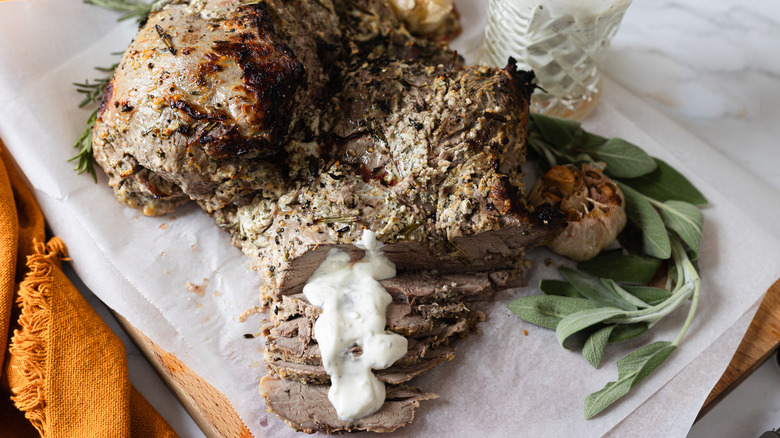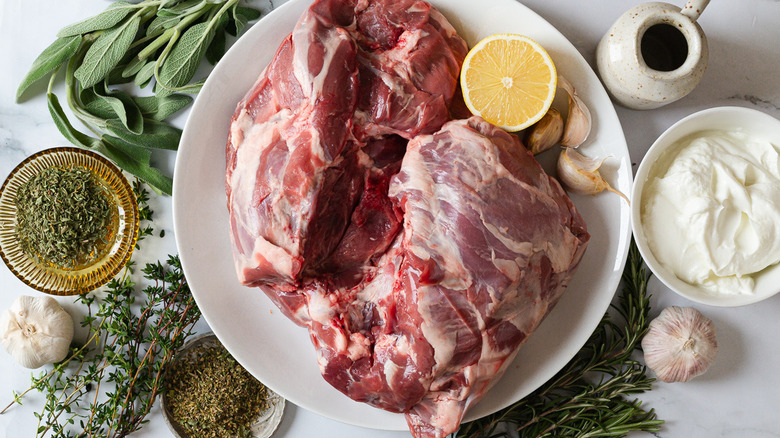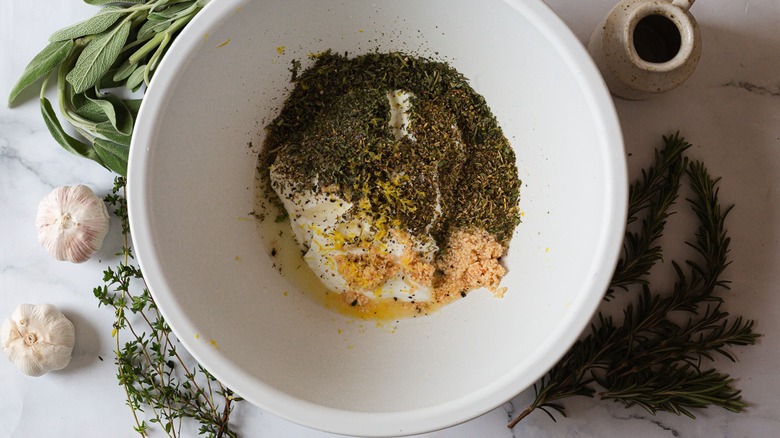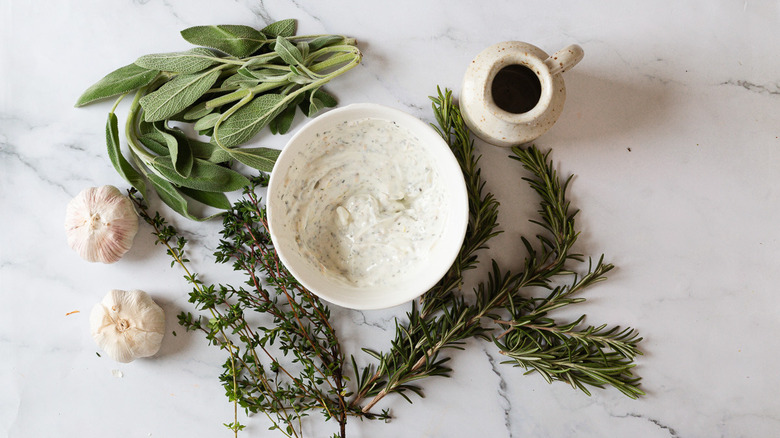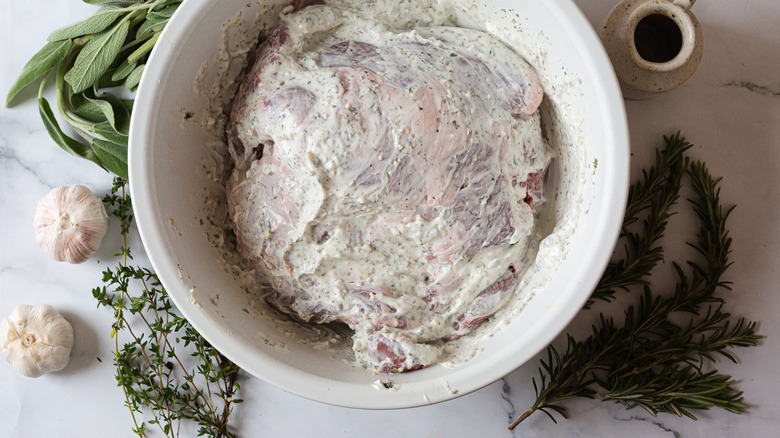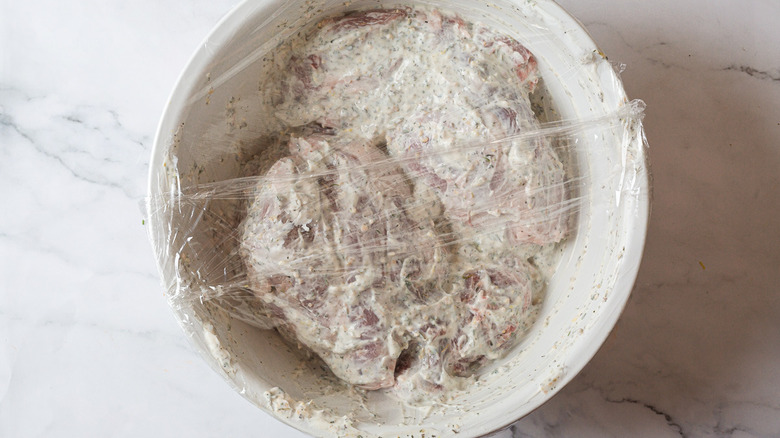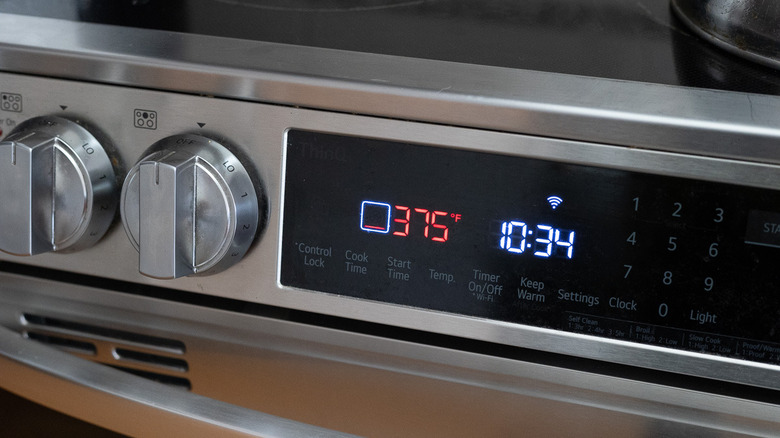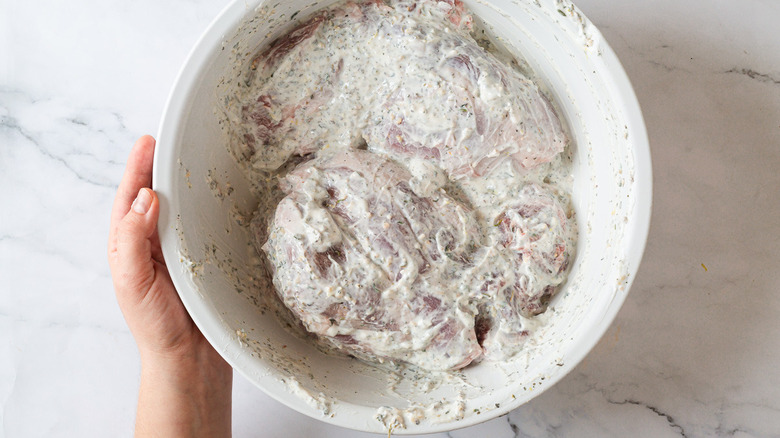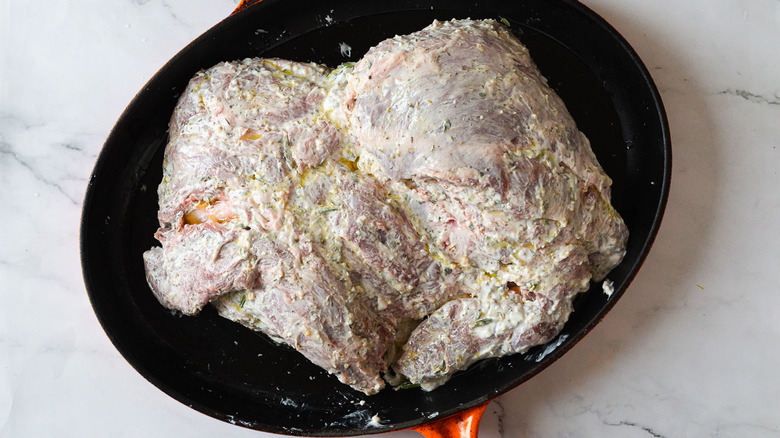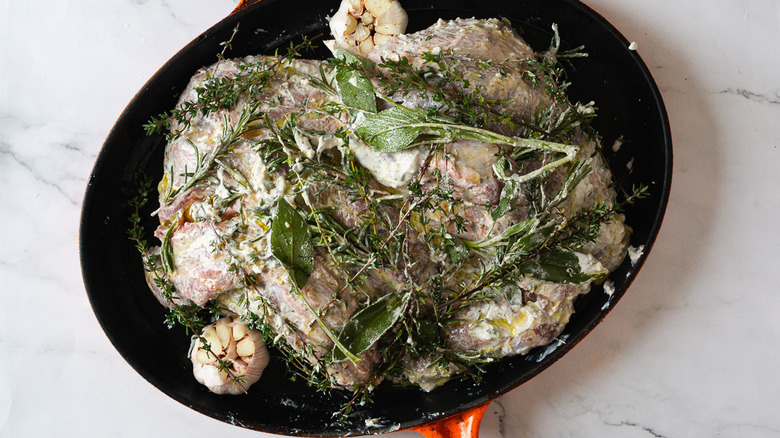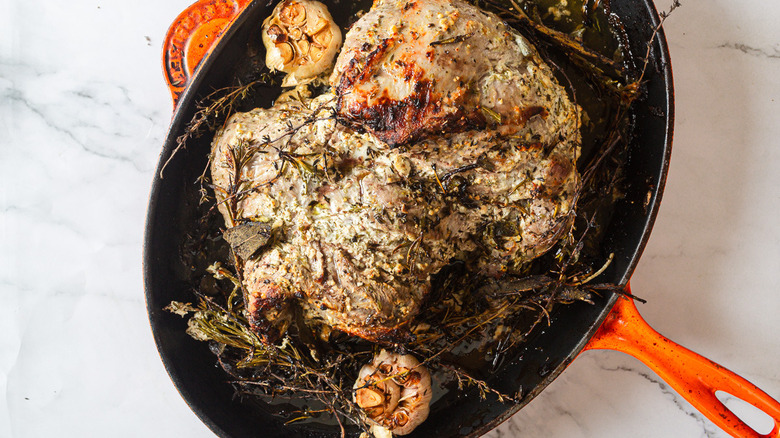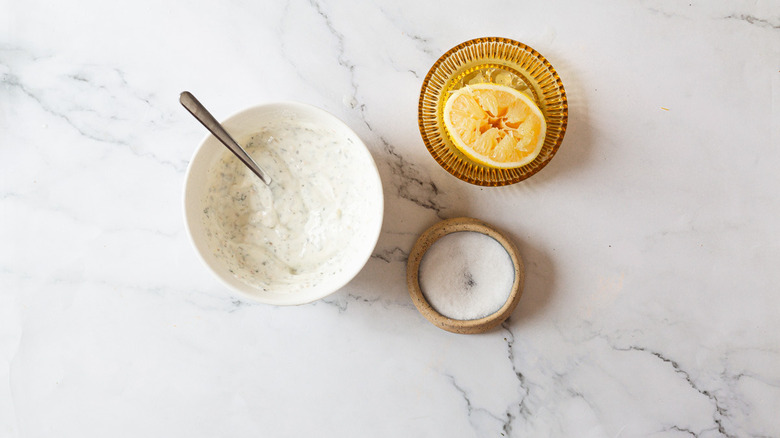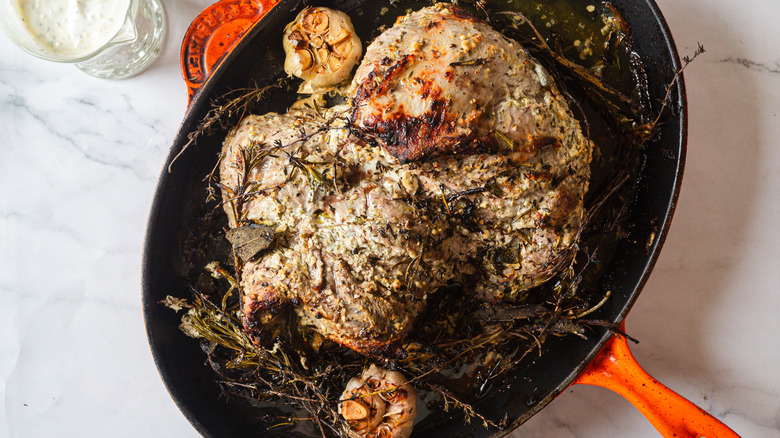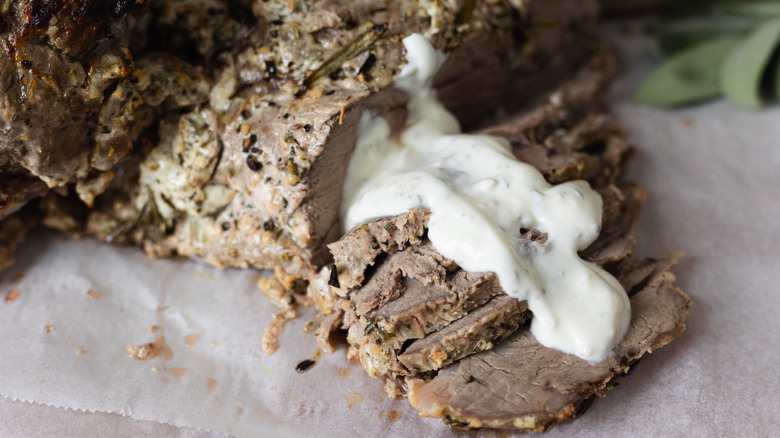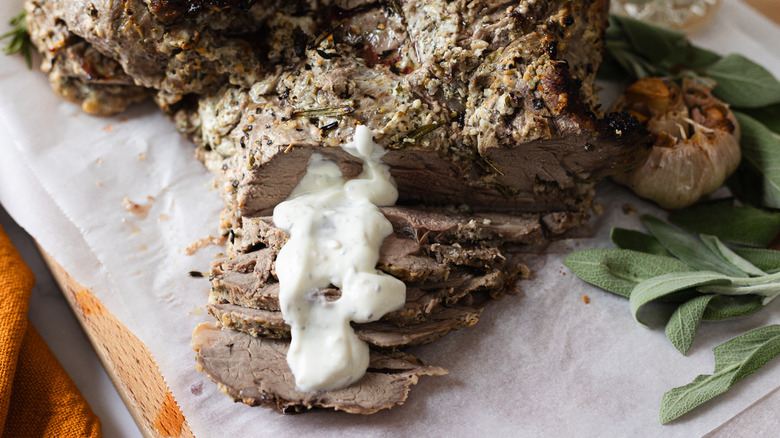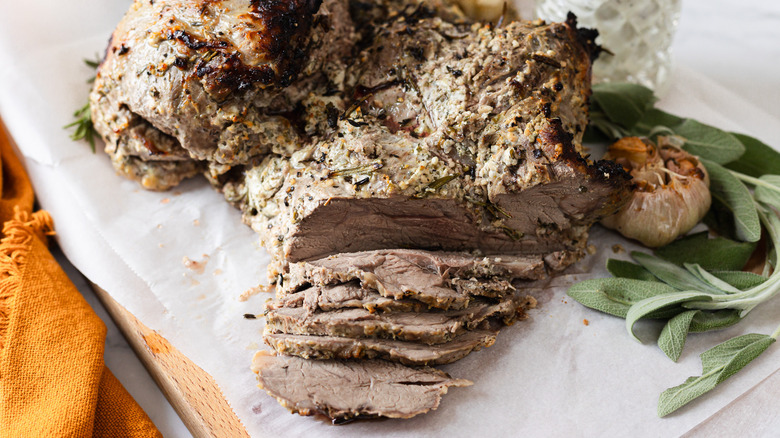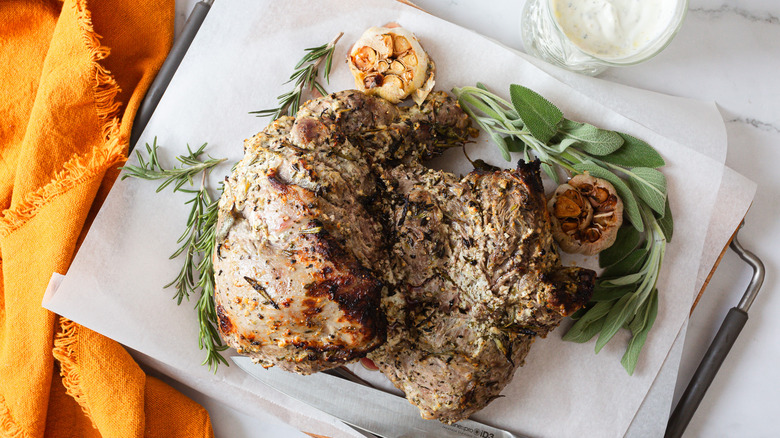Perfect Boneless Roasted Leg Of Lamb Recipe
A leg of lamb can be an intimidating cut to cook; it is big and sometimes unwieldy, and many a home cook has been intimidated by its sheer volume. But we draw inspiration from the Mediterranean to offer a boneless roasted leg of lamb recipe that is tender, flavorful, and perhaps most importantly, surprisingly easy to make.
According to Ksenia Prints of At the Immigrant's Table, a boneless leg of lamb can be the perfect centerpiece to a festive meal. We turn to the tenderizing qualities of Greek yogurt to make a marinade that makes this meat especially moist, working through all of its knots and crevices and infusing it with mountains of flavor. Fresh and dried Herbes de Provence, thyme, rosemary, and sage join garlic for the perfect flavoring, going beautifully with the Mediterranean theme of the whole dish.
The key to unlocking the full potential of this dish lies in the balance of flavors and proper marination time. With just an hour of preparation and marinating, along with an hour of cooking, you can transform a simple cut of meat into a mouthwatering feast. Our simple process and straightforward, punchy flavors allow the lamb's natural flavors to shine through. Accompanied by a homemade yogurt-herb sauce, this roasted leg of lamb will be a memorable addition to any meal!
Gather the ingredients for roasted leg of lamb
Prepare to cook your roasted leg of lamb by collecting all the ingredients necessary for this flavorful dish. Your shopping cart should include plain Greek yogurt, which serves as the base for a tangy marinade, alongside fresh lemon for both zest and juice to add a citrus note. We will need a few heads of garlic, both for minced cloves for the marinade, and for roasting alongside the lamb. Herbes de Provence, dried thyme, and dried sage contribute an aromatic herbal profile to the dish. The main attraction, a boneless leg of lamb, will be complemented by olive oil, kosher salt, and freshly cracked pepper for proper seasoning. To decorate the dish, we turn to fresh thyme, sage, and rosemary, which will contribute freshness to the meat as it roasts to perfection.
Step 1: Prepare the marinade
In a bowl, combine yogurt, zest, and juice of one lemon, minced garlic, dried Herbes de Provence, dried thyme, dried sage, salt, and black pepper. Mix well to create a smooth marinade.
Step 2: Save a cup
Set aside one cup of the marinade for later use.
Step 3: Marinate lamb
Place the boneless lamb leg in a large dish or a resealable plastic bag. Coat it thoroughly with the remaining marinade.
Step 4: Set aside for an hour
Cover the dish with plastic wrap or seal the bag and refrigerate for at least 1 hour, or preferably overnight, to allow the flavors to penetrate the meat.
Step 5: Preheat oven
Preheat your oven to 375 F.
Step 6: Bring to room temperature
Remove the marinated lamb from the refrigerator and let it come to room temperature for about 30 minutes.
Step 7: Transfer to baking dish
Place the lamb in a well-oiled roasting pan or on a baking sheet lined with parchment paper.
Step 8: Garnish
Top the lamb with olive oil, marinade leftover in the bowl, garlic heads, and fresh sage, thyme, and rosemary.
Step 9: Roast the lamb
Roast the lamb in the preheated oven for about 50 minutes to 1 hour, or until the internal temperature reaches your desired doneness (medium-rare is around 145 F).
Step 10: Prepare yogurt herb sauce
While the lamb is roasting, prepare yogurt-herb sauce. Mix the reserved 1 cup of marinade with 1 teaspoon of lemon juice and 2 teaspoons of olive oil. Taste and add salt and pepper as needed.
Step 11: Rest the lamb
Once the lamb reaches the desired temperature, remove it from the oven and let it rest for about 15 minutes before serving.
Step 12: Serve the perfect boneless roasted leg of lamb
Serve lamb with the yogurt-herb sauce on the side.
How do I know when the lamb is done?
Determining when the roasted leg of lamb has reached the ideal degree of doneness requires accuracy. The most reliable method is to insert a meat thermometer into the thickest part of the roast, avoiding the fat and gristle. When the thermometer reads 145 F, you can remove the lamb from the oven. This internal temperature will yield a medium-rare result that highlights the tender texture and rich flavor of the meat, leaving some of the meat slightly underdone inside and the exterior well-cooked.
For those who prefer a visual test, you can also make a small cut into the lamb to examine the color. Perfectly cooked lamb will be lightly blushing pink at the center, with just a touch of rosiness remaining. While the outer layers may appear gray-brown, the interior should not be fully cooked through. Allowing the roast to rest for 15 minutes after removal from the oven also allows the temperature to rise slightly and the juices to redistribute throughout the cut. With either the thermometer test or visual inspection, achieving an internal temperature of around 145 F will guarantee that you end up with succulent, juicy lamb rather than a flaccid, tough cut of overcooked meat.
Can I roast the leg of lamb a day in advance?
While freshly roasted lamb is certainly delicious and served immediately after cooking, preparing the leg in advance allows for easy entertaining or meal prep on a busy schedule. It is perfectly possible to roast the boneless leg of lamb for up to one day before serving, and some even prefer it to let the flavors develop fully. After removing the cooked roast from the oven, allow it to cool completely at room temperature then wrap it tightly in plastic wrap or foil before refrigerating overnight.
When ready to serve, simply slice the chilled lamb and place the pieces on a baking sheet. You can then reheat it in a 350 F oven until the internal temperature reaches 145 F and the meat is warmed through, which should take about 20 minutes. This will revive the lamb to its full flavor and juiciness, making roasted leg of lamb a realistic option even for time-pressed dinners!
What cut of lamb can I use in place of a boneless leg of lamb?
While the recipe was developed especially for a boneless leg of lamb, there is flexibility if that particular cut is unavailable. An ideal substitute would be a boneless butterflied leg of lamb, which allows for even cooking and penetration of marinades and spices like the boneless roast. Another good option is boneless lamb shoulder roast, which offers a similar boneless cooking experience. You can also absolutely use a bone-in leg of lamb, keeping in mind some adjustments to the cooking instructions.
The bone-in cut will require increasing the oven time to 1-1 ½ hours depending on size, as the presence of bone can slow the cooking process. It's a good idea to tent the lamb loosely with foil if the outside browns too quickly before the inside is done. Regardless of cut, lamb should be cooked until it reaches the internal temperature of 145 F for medium-rare doneness. It may take a bit longer to reach with a bone-in piece, as there is less surface area exposure. Be sure to rotate the lamb halfway through roasting as well.
Perfect Boneless Roasted Leg of Lamb Recipe
Accompanied by homemade yogurt-herb sauce, this roasted leg of lamb offers straightforward, punchy flavors allowing the lamb's natural flavors to shine through.
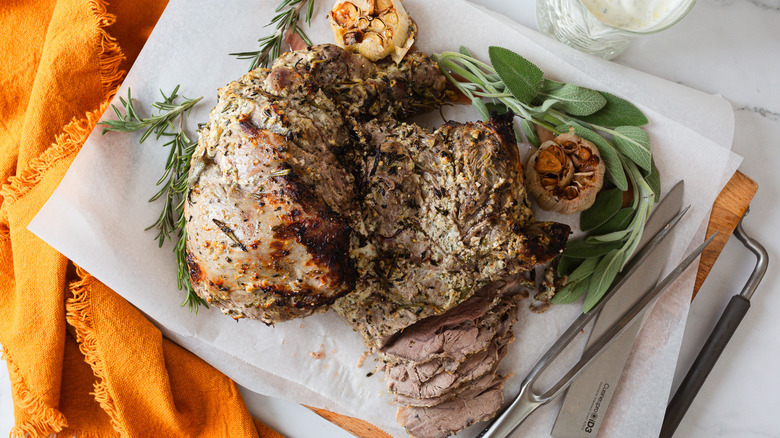
Ingredients
- For the Marinade
- 1 ½ cups plain Greek yogurt
- 1 lemon, juice and zest, plus 1 teaspoon lemon juice, divided
- 2 garlic cloves, minced
- 2 tablespoons Herbes de Provence
- 2 teaspoons dried thyme
- 2 teaspoons dried sage
- Kosher salt, to taste
- Freshly cracked pepper, to taste
- For the Roasted lamb
- 6-pound boneless leg of lamb
- 2 tablespoons, plus 2 teaspoons olive oil, divided
- 2 garlic bulbs, tops cut off
- 4 stems fresh thyme
- 4 stems fresh sage
- 4 stems fresh rosemary
Directions
- Prepare the Marinade. In a bowl, combine yogurt, zest and juice of one lemon, minced garlic, dried Herbes de Provence, dried thyme, dried sage, salt, and black pepper. Mix well to create a smooth marinade.
- Set aside 1 cup of the marinade for later use.
- Place the boneless lamb leg in a large dish or a resealable plastic bag. Coat it thoroughly with the remaining marinade.
- Cover the dish with plastic wrap or seal the bag and refrigerate for at least 1 hour, or preferably overnight, to allow the flavors to penetrate the meat.
- Preheat your oven to 375 F.
- Remove the marinated lamb from the refrigerator and let it come to room temperature for about 30 minutes.
- Place the lamb in a well-oiled roasting pan or on a baking sheet lined with parchment paper.
- Top the lamb with olive oil, marinade leftover in the bowl, garlic heads, and fresh sage, thyme, and rosemary.
- Roast the lamb in the preheated oven for about 50 minutes to 1 hour, or until the internal temperature reaches your desired doneness (medium-rare is around 145 F).
- While the lamb is roasting, prepare yogurt-herb sauce. Mix the reserved 1 cup of marinade with 1 teaspoon of lemon juice and 2 teaspoons of olive oil. Taste and add salt and pepper as needed.
- Once the lamb reaches the desired temperature, remove it from the oven and let it rest for about 15 minutes before serving.
- Serve lamb with the yogurt-herb sauce on the side.
Nutrition
| Calories per Serving | 656 |
| Total Fat | 44.5 g |
| Saturated Fat | 18.8 g |
| Trans Fat | 0.0 g |
| Cholesterol | 190.8 mg |
| Total Carbohydrates | 7.2 g |
| Dietary Fiber | 1.3 g |
| Total Sugars | 1.7 g |
| Sodium | 787.3 mg |
| Protein | 54.5 g |
